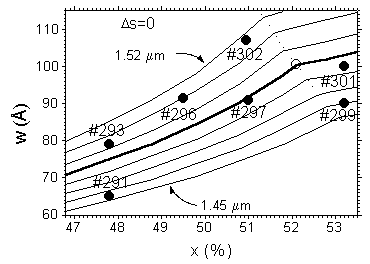InGaAs/InAlAs multiple quantum well structures for amplitude modulation
:: References :: Other projects
InGaAs/InAlAs multiple quantum well structures have been studied in great detail for application in optical modulators based on the quantum confined Stark effect. MQW structures with different quantum well thicknesses and alloy composition were grown by LP-MOVPE. Photoluminescence and X-ray diffraction measurements together with a calculation of the Schrödinger equation within the effective mass approximation allowed the determination of the quantum wells' and barriers' thicknesses, the alloy composition in quantum well, the lowest optical transition energy and the heavy hole-light hole splitting with great precision. These data are shown in figure 1.
Several parameters related to the performance of amplitude modulators, namely: contrast ratio, Stark shift, insertion loss, chirp parameter, polarization independence and change in absorption per applied volt were determined using photocurrent measurements as a function of externally applied voltage and absorption measurements. Record values for some figures of merit were obtained.

Fig. 1 Well width (w) vs. gallium concentration (x) for the lowest transition energy of the quantum wells. Each line corresponds to a different emission wavelength differing by 10 nm from each other. The lower and upper curves represent the 1.45 µm and the 1.52 µm emission, respectively. The thicker line corresponds to the emission at 1.49 µm. The dotted line represents the well width vs.gallium concentration which results in degenerate heavy- and light-hole energies (Ds = 0). The open circle shows the interception between the curve representing the 1.49 µm emission and the Ds = 0 curve. The dots represent the investigated samples.
In addition, simulations of the absorption spectra of such semiconductor structures are performed by calculating the electronic structure through a 4 x 4 Luttinger-Kohn hamiltonian. The excitonic interaction, stress and residual doping are taken into consideration. From the absorption spectra, it is possible to obtain all device parameters. Simulation of the modes propagation in the waveguides are performed by using the effective index method and BPM.
The results obtained can be found in the following references:
Amplitude Modulators based on the Stark Effect
P. L. Souza, M. P. Pires, B. Yavich, F. Racedo and C.V-B. Tribuzy
Microelectronics Journal 33, 341-348, 2002
Chirp parameter for InGaAs/InAlAs multiple quantum well amplitude modulators near polarization independence
M. Pamplona Pires, B. Yavich e P. L. Souza
Applied Physics Letters, 75, 271, 1999 e apresentação no XXII ENFMC, São Lourenço, MG, Brasil, maio de 1999.
On the optimization of InGaAs/InAlAs quantum well structures for electro-absorption modulators
M. Pamplona Pires, B. Yavich, R. G. Pereira, P. L. Souza e W. Carvalho
Apresentado na 11th International Conference on Superlattices, Microstructures and Microdevices, Hurghada, Egito, julho de 1998, IEEE Journal of Lightwave Technology 18, 598, 2000.
Improved determination of heavy hole mass in InGaAs quantum wells.
M. Pamplona Pires
Apresentação no 9th Brazilian Workshop on Semiconductors Physics, Belo Horizonte, MG, Brasil, fevereiro de 1999.
Measurement of heavy and light hole masses in InGaAs/InAlAs quantum wells
M. Pamplona Pires, T. Y. Chang e N. J. Sauer
Brazilian Journal of Physics, 27/A, no. 4, 223 , 1997 e apresentação no 8th Brazilian Workshop on Semiconductors Physics, Águas de Lindóia, SP, Brasil, fevereiro de 1997.
Insensitive polarization waveguide amplitude modulator on strained InGaAs/InAlAs MQW
F. Racedo N., M. Pamplona Pires, L. C. D. Gonçalves, B. Yavich e P. L. Souza
Apresentação no XXII ENFMC, São Lourenço, MG, Brasil, maio de 1999.
InGaAs/InAlAs Strained Multiple Quantum Wells for Efficient Amplitude Modulators
C.V-B. Tribuzy, M. P. Pires, P. L. Souza e B. Yavich
IEEE Transactions on Microwave Theory and Techniques 52, 1592-1597 (2004).
